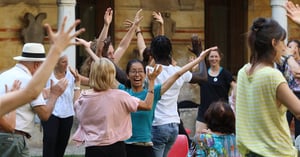©Photo credits: Roberto Cinconze, Dance Well archive
The theme of Cultural welfare has been included for the first time in the prestigious annual report on cultural and creative endeavours entitled “Io sono Cultura” (I am Culture) published by the Symbola Foundation.
The article, authored by Catterina Seia and Annalisa Cicerchia (Senior Researcher at ISTAT, the Italian Statistics Agency), deals with the growing number of artistic projects that are focused on cultural welfare, “both inside and outside places specifically dedicated to culture and care”.
“In hospitals, people tell stories, read, make music, dance, and stage theatrical performances. Museums and theatres offer ‘experiential itineraries’ for people with degenerative diseases and their care-givers. We are seeing an increasing number of artistic projects involving schools, prisons, and disadvantaged communities in their respective territories and aimed to promote life-long human regeneration, from the perinatal period to the ‘fourth age’, with a very positive cost-effectiveness ratio.” Some of these projects have been recognised as best practices for health promotion and medical humanities, but, as most of them are small and fragmented, they have so far had no impact on political decision-making. As Pier Luigi Sacco, cultural economist and associate founder of CCW, maintains, “what is missing is the ability to bring these projects into a system in a territorial context and to make them the driving force of a new strategy of social quality feeding the ongoing redesign of welfare as ‘generative welfare’. For these practices to have an impact, it is essential to encourage the transition from numerous small pilot experiments to a process of development of true territorial policies. To generate social innovation, practice must become policy.”
Among the best practices, included among the cases of scientific interest in the WHO report, there is the Dance Well – movement research for Parkinson’s project, which was conceived and promoted by Roberto Casarotto of the Centro per la Scena Contemporanea – Casa della Danza (Contemporary Scene Centre – Dancehouse) in Bassano del Grappa, Italy. This project, carried on in dialogue with various health facilities, has its roots in experiments that have been conducted successfully for almost twenty years in the United States and the Netherlands. Since 2013, people with Parkinson’s, their care-givers and anyone else who wishes to join in, as the activity is open to all, have met in the halls of the Civic Museum to dance together among the sculptural masterpieces of Canova. Art is the “expression of one’s body. The participants are dancers and as dancers – not as people with Parkinson’s – they take their dance classes”. At the same time, they improve their sense of balance and movement, develop interpersonal relationships and break out of their isolation. Since 2015, this project has been exported to other territories in northern Italy and, in 2019, it arrived in Japan, at the Metropolitan Art Museum in Tokyo, as well as in Kyoto and Kanazawa.
The Musei Toscani per l’Alzheimer (Museums of Tuscany for Alzheimer’s) project is active in Italy in a network of more than 60 museums that, through their Educational Departments, develop activities for people with dementia and their care-givers. The activities are conducted by professionals with specific skills and experience in geriatrics and dementia treatment, as well as in the artistic, educational and museum fields. This hybrid approach allows the development of inclusive activities for care-givers and strengthens their relational approaches for the management of this complexity. This involves not only special visits to museums, but also a participatory itinerary over several months of creative and sensorial interaction with works of art. The project began in early 2000, at the MoMa in New York, as the heart of a strategy of universal accessibility, also open to people with cognitive disabilities, and has had impacts on the quality of artistic research, as well as on the quality of life of people with dementia and others who are involved with it. It later moved on to experimenting with reminiscence therapies and creative interaction. In Italy, two museums, both located in Florence, are leading project development: Palazzo Strozzi and Marino Marini, leader of the Erasmus + “MA&A Museums Art & Alzheimer’s” higher education project, involving five European countries, between 2015 and 2017.
These two projects share their origin in international contexts, their acceptance of great contemporary challenges, their territorial translation, which takes into account specificities at the local level, their interdisciplinary co-design, which involves health, socio-welfare and cultural operators and their organisations, their involvement of the “care chain” (family and professional care-givers, who are important for a biopsychosocial approach to the process of management and treatment of the diseases involved), and their creation of new skills and scientific evaluation processes.
These are all indispensable elements for the exportability of project designs beyond the contexts in which they were developed and for their incorporation into policies.
Catterina Seia
Member of the IBSA Foundation Advisory Board; Founder of CCW Cultural Welfare Centre; Co-Founder and Vice-President of the Fitzcarraldo Foundation; Vice-President of the “Medicina a Misura di Donna” Foundation.

